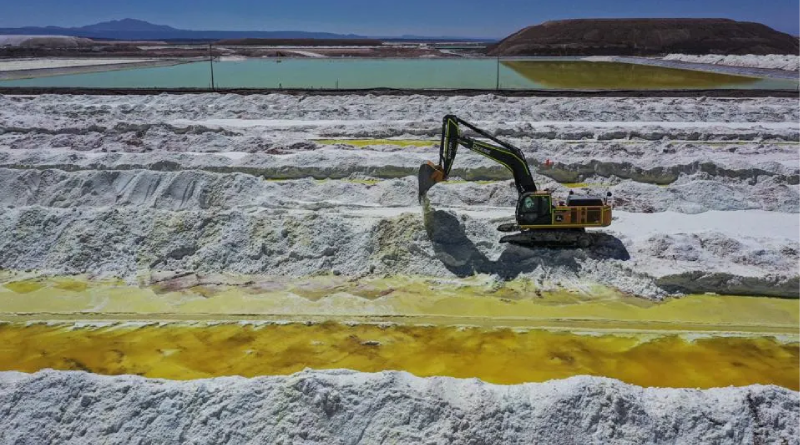Lithium: Price Collapse Secures Green Transition, Causes Headaches
By Ariel Cohen, alumnus of The Fletcher School, Senior Fellow at Atlantic Council
Lithium is earning its current moniker, “white gold,” and all the geopolitical contention that comes with it. When Argentina’s new libertarian president, Javier Milei, announced sweeping reforms, a prominent one was making it easier to export lithium. The U.S. subsequently announced financial support to make that happen. When Namibia conflicted with a Chinese mining company, it was over the export of lithium. After the fall of Kabul to the Taliban, one of the few economic opportunities that emerged was for the export of lithium from the Taliban-ruled Emirate. Worldwide, the scramble for lithium is already happening.
Lithium is vital because of its indispensability in modern green technologies, especially advanced batteries. This scramble for white gold has had enormous benefits. Countries in the developing world have been able to tap into vital new revenue streams even as the price of lithium was pushed downwards. The result should have been a virtuous cycle of cheap and stable commodities for the producers of green technologies, especially electric vehicles (EVs), able to count on cheaper inputs and thus sell at lower prices to supplant the internal combustion engine (ICE).
Unfortunately for all, this vision has been interrupted by some of the perennial enemies of the orderly market – human greed and poor planning. Just over a year ago, lithium prices were sitting at nearly $80,000 a ton in December 2022. The U.S. government was so worried about the metal’s price and its impact on advanced technologies it enacted a comprehensive supply review. EV makers, including TeslaTSLA -2.7%, were scrambling to buttress their own lithium supplies. Lithium sellers such as Ganfeng Lithium, the Albemarle Corporation, and others were so swamped with orders they were holding auctions, which routinely pushed prices upward.
Then, the bubble burst. In one year, the cost of lithium has dropped a staggering 80%. Lithium prices currently hover at approximately $13600 a ton as of December 18th 2023.
At first glance, this may seem unremarkable. Commodities fluctuate all the time, and over-investment in production is hardly a unique story. What separates lithium, and what makes this situation so dangerous, is the intense geopolitical competition lithium is subject to, the regulatory environment lithium interfaces with, and lithium’s role in combating climate change.
While theoretically, EV makers can produce more vehicles with dropping battery prices, demand for EVs has slowed as leaders such as Tesla try to produce vehicles for the mass market. Previously, the market appealed to luxury buyers and early adopters, creating significant growth. EV producers must now make their vehicles more affordable in the face of plateauing demand, and expand their market share from 9% of new car sales (in the US) to at least 25%, but they can only decrease prices so much before it eats into their bottom lines.
Tesla decreased their prices in some cases by 30% this year, yet it hasn’t seemed to be enough to increase demand. Other EV producers, such as GM and Ford, have stalled their plans to further EV production, demonstrating that although EV sales are still continuing, it’s not enough to push legacy car manufacturers toward increased production of their second-rate product.
As with many new industries, expansion is tough. AlbemarleALB -1.7% Corp., the biggest miner of lithium, explained that some producers have already started to decrease operations as prices fall. This is a new development, considering earlier this year, the company predicted that China’s EV market would expand by 40%. Earlier in March, Susan Zou, Shanghai-based vice president at Rystad Energy, commented on these concerns, “Demand is still healthy, but battery and EV makers are currently destocking instead of placing new orders. The subdued spot demand therefore is weighing on sentiment and pressing down prices.”
A degree of stability is necessary in order to rescue the lithium market. Prices of lithium need to be low enough that consumers, such as battery manufacturers, can make a profit, but high enough to encourage suppliers towards long-term expansion and investment.
While in the short term, this price crash is a boon for those who previously struggled to purchase lithium and some green industries that consume lithium, in the long term, this price collapse will prove damaging to the green energy industry. Fears over another crash, current capital losses, and a lack of production increase even when input prices are at rock bottom may stymie efforts to increase lithium production for years.
This price crash should remind everyone that green energy is just as susceptible to market forces as its competitors in the fossil fuels industry. On balance, this is an overwhelmingly positive thing, as the maturation of green energy has made solar electricity cheaper than coal and created large, moneyed constituencies interested in the success of green energy.
Market forces are here to stay. Environmental advocates ignore the market (often focusing on political or social campaigns) at their own peril. To paraphrase Pericles, some environmentalists may not be interested in the market, but the market remains interested in them.
(This post is republished from Forbes.)

